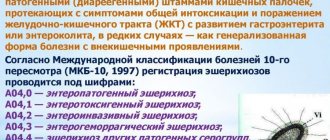Pharmacodynamics
This enzyme preparation, as Wikipedia indicates, is intended to improve digestive processes. The pancreatic enzymes included in its composition promote the breakdown of proteins, fats and carbohydrates, leading to complete absorption in the small intestine. The main substance pancreatin is also the INN of the drug.
According to the abstract, the capsule shell easily dissolves in the stomach, resulting in the release of many mini-microspheres. Thus, mini-microspheres are mixed with intestinal contents, improving the distribution of enzymes within the intestine.
Action
The pathological state of enzyme deficiency in diseases of the pancreas and gastrointestinal tract negatively affects digestive function, interferes with the normal breakdown of proteins, fats and carbohydrates, and the absorption of nutrients by the body. Outwardly, this manifests itself as signs of digestive dysfunction. Among them:
- pain;
- nausea, urge to vomit;
- increased gas formation;
- defecation disorder.
When ingested, Creon 10000 capsules quickly dissolve. Minimicrospheres are released and, together with food, enter the intestines, where they begin their therapeutic activity. In the small intestine, the acid-resistant membrane dissolves. This releases pancreatic enzymes, which are necessary to break down nutrients from food. They are then absorbed in the intestine or broken down by intestinal enzymes.
In terms of its structure, the active substance of the drug "Creon 10000" is of a protein nature. To exhibit therapeutic activity, it does not require absorption in the intestine. The drug works when it passes through the gastrointestinal tract. In the body, pancreatin, like other proteins, is broken down into amino acids and peptides.
Indications for use of Creon
The main indications for use are:
- carrying out replacement treatment for insufficient exocrine pancreatic function accompanying the following diseases: cystic fibrosis , chronic pancreatitis , pancreatectomy , pancreatic cancer , obstruction of the gastrointestinal tract due to neoplasms, Shwachman-Diamond syndrome , as well as in elderly patients;
- symptomatic treatment of digestive disorders with: partial gastrectomy , total gastrectomy , biliary obstruction , liver cirrhosis , cholestatic hepatitis , terminal pathologies and excessive bacterial growth in the small intestine.
Pharmacological properties of the drug Creon
Creon contains pancreatin of porcine origin in the form of enteric-coated (stable in acidic environment) minimicrospheres in gelatin capsules. The capsules dissolve quickly in the stomach, releasing hundreds of mini-microspheres in a multi-dose manner, which ensures good mixing with the stomach contents, transport from the stomach along with its contents and, after release, good distribution of enzymes within the intestinal contents. When the minimicrospheres enter the small intestine, the shell quickly dissolves (at pH 5.5), releasing enzymes with lipolytic, amylolytic and proteolytic activity, which ensures the breakdown of fats, carbohydrates and proteins. The products of pancreatic digestion are then absorbed either immediately or after further hydrolysis by intestinal enzymes. In animal studies, there was no evidence of enzyme absorption in unchanged form, and therefore classical pharmacokinetic studies were not performed. Pancreatic enzyme supplements do not require absorption to be effective. On the contrary, their full therapeutic effect is manifested in the lumen of the gastrointestinal tract. Moreover, as substances of protein origin, they undergo proteolytic cleavage while passing through the gastrointestinal tract before being absorbed in the form of peptides and amino acids. Data from preclinical studies do not indicate acute, subchronic or chronic toxicity.
Creon capsules, instructions for use (Method and dosage)
Instructions for use Creon 10000 recommends prescribing them to small patients. In general, this drug of any quantity of units is taken orally. The dosage is selected individually and depends on age, severity of the disease and type of diet. It is usually recommended to take part of the medicine before meals, and the rest with food.
At the beginning of treatment, tablets are prescribed in a dosage of 10,000–25,000 units. When it is necessary to reduce steatorrhea and maintain optimal patient condition, the dose may be increased. In medical practice, patients can receive an average of 20,000–50,000 units of EP lipase.
During the treatment of cystic fibrosis, the dosage is determined depending on the weight. For example, when treating small patients under 4 years of age, 1000 lipase units per kg of weight are prescribed, and over 4 years of age, 500 lipase units per kg of weight with each meal. For many patients, the daily dosage should not exceed 10,000 units per 1 kg of weight.
Instructions for use Creon 25000 recommends taking it in the treatment of other conditions that may be accompanied by exocrine pancreatic insufficiency. In this case, the dose is set taking into account the individual characteristics of the patient, for example, how much digestion is impaired, how much fat is contained in the food, and so on.
Instructions for use of Creon for children contain a detailed description of how to give it to children with difficulty swallowing. To use this drug for children, the capsules must be carefully opened. The internal contents are mixed with liquid or food that does not require chewing. It must be remembered that such mixtures cannot be stored, so take them immediately after they are prepared. It is forbidden to crush or chew mini-microspheres and add them to acidic foods - this can destroy their shell, which protects them from the effects of gastric juice.
Instructions for use Creon 40000 recommends taking this drug for adult patients. Its dosage also depends on the severity of the disease and the personal characteristics of the patient. The duration of use must be determined by the attending physician.
Dosage
Replacement therapy with enzyme preparations requires medical supervision. The doctor pays attention to the cause of enzyme deficiency, the patient’s age and body weight. The dosage of Creon 10000 is measured in lipase units. For example, at the beginning of treatment for cystic fibrosis, adult patients require 500 units of lipase per kilogram of body weight per meal. In the future, the dosage should not exceed 10,000 units/kg body weight per day with regular monitoring of steatorrhea.
Since patients with cystic fibrosis receive increased dosages of the drug, constant monitoring of the condition of the intestines is necessary due to the risk of developing fibrosing colonopathy. In medical practice, there are cases where, against the background of regular intake of large doses of pancreatin, a person developed strictures of certain sections of the intestine. In this condition, the intestinal lumen narrows, making it difficult for food to pass through. To avoid complications, it is important for patients with cystic fibrosis to undergo regular medical examinations and take timely measures if there are signs of intestinal obstruction.
As for other diseases that are accompanied by a decrease in pancreatin production, here it is necessary to take into account not only the severity of the disease, but also the characteristics of the patient’s diet. Typically, for adults, the dosage ranges from 25,000 to 80,000 units per meal. These dosages are suitable for a full meal, and for snacks it is enough to take half the dose. The need for lipase increases if the diet contains a lot of fatty foods.
If the patient does not have gastrointestinal diseases, and enzyme deficiency is caused by an improper diet, 10,000 to 20,000 units of pancreatin are required per meal. It is important to remember that the prescription and dosage of the drug should be agreed with your doctor.
special instructions
There have been cases when patients treated for cystic fibrosis received pancreatin in high dosages, which caused colitis , strictures of the cecum and ileum.
For this reason, it is necessary to monitor the dose, especially when Creon 40000 is prescribed. It is also necessary to monitor the appearance of any symptoms and changes that occur in the abdominal cavity. In addition, you should immediately find out how to take Creon to 10,000 adult patients and not exceed its dosage.
Creon for children
An enzyme preparation is prescribed to children when they need to improve digestion. The recommended daily dosage of Creon 10,000 for children is divided into several parts and taken with each meal.
When prescribing it, parents need to immediately find out from the doctor how to take Creon for children, since the dose is prescribed taking into account the baby’s weight.
It should be noted that reviews for the child are very ambiguous. Some mothers report the effectiveness of the capsules, but there are also reviews about the uselessness of this medicine.
Creon for babies
When this drug is prescribed to children, many parents immediately have questions: what is Creon and what is it taken for? It is known that the gastrointestinal tract of newborns develops over a certain period of time. Therefore, even small deviations in the diet for infants can cause problems.
Also, mothers begin to worry about how to give capsule medicine to their infant? In fact, the pediatrician explains all this in detail and describes the instructions for the drug. It should be noted that Creon 10000 is usually prescribed for newborns, indicating the dosage, regimen and duration of therapy.
Reasons to prescribe capsules for newborns are:
- constant colic;
- constipation or diarrhea with particles of undigested food;
- bloating.
By the way, reviews from parents show that the question of how to give this medicine to a baby is not a problem at all. Many mothers are confused by the effect of the drug, since its effectiveness is not always evident.
Analogues of Creon
Level 4 ATC code matches:
Digestin
Pancitrate
Mezim
Festal
Pankreoflat
Pancreazim
Enterosan
Panzinorm Forte
Panzinorm
Micrasim
Enzistal P
Pancreatin
Penzital
Pangrol
Hermital
Abomin
The main analogues of Creon 10000 and other units:
- Panzinorm
- Micrasim
- Penzital
- Pangrol
- Mezim
- Pancreazim
- Gastenorm
- Enzistal
- PanziCam
- Pancreatin
However, this does not mean that each of them is an equivalent substitute.
It should be noted that the price of analogues can be very different and cannot incline towards the purchase of one or another medicine. The question of what can replace treatment should be clarified with a doctor. Especially when the medicine is selected for children under one year of age.
Creon or Pancreatin - which is better?
Despite many similarities, each of these drugs has significant differences. But if you know what the difference is, then you can make the right choice when buying a medicine.
If we compare how Creon differs from Pancreatin , then the first is the form of release. Pancreatin is available in tablets. The second difference is the concentration of the active substance, which in Pancreatin is presented in arbitrary content.
The effect of drugs is also different - Pancreatin already acts in the stomach and therefore does not fully perform its function, which is why it is considered less effective. Although its cost is much lower.
Thus, based on these data, each patient will be able to decide which drug to choose.
Hermital or Creon - which is better?
The compositions of these drugs are quite similar, but Ermital is less effective due to the type of active ingredient. Creon mini microgranules easily mix with the contents of the stomach, significantly improving physiological digestion, while other products have a somewhat delayed effect.
Which is better: Creon or Micrasim?
These products are almost identical in everything, but they differ in the dosages of their components.
For example, Micrasim contains 320 mg of pancreatin. In addition, it is a domestically produced medicine and is cheaper.
Therefore, when prescribing this drug, it is important to take into account the high content of the enzyme, since such a difference is noticeable and can lead to complications in the digestive tract.
Creon or Panzinorm - which is better?
Another absolute analogue is Panzinorm . It is produced by the KRKA brand from Slovenia. This medicine is also used in the treatment of enzyme deficiency.
It is believed that each of them has the same effectiveness, and which drug is suitable for treatment, you need to choose yourself, but still on the recommendation of a doctor.
Rotavirus - treatment and prevention
Moiseeva Tatyana Sergeevna
Pediatrician, Infectious disease specialist
April 25, 2021
intestinal infections sooner or later. After acute respiratory viral infections (ARVI and influenza), this is the most common reason for visiting a doctor in childhood. They are a problem not only for the child, but also for the whole family. Perhaps the most common intestinal infection at the moment is rotavirus or, as parents often call it, “intestinal flu”.
Regardless of the social status of the family and the sanitary and hygienic situation in the house, from birth to 5 years, almost all children suffer from rotavirus gastroenteritis . According to statistics, more than 137 million people worldwide suffer from this infection every year, approximately a quarter of whom are hospitalized. Unfortunately, there are cases with fatal outcomes, including in children. Rotavirus gastroenteritis is most severe in children when they first encounter the virus, which usually happens between the ages of 6 and 18 months. In babies who are bottle-fed, the risk of infection and a more severe course is slightly higher.
Adults are also susceptible to this infection. You can become infected repeatedly during your life, since natural immunity to the virus is type-specific (it protects only against a specific type of rotavirus and does not protect against others). With repeated contact with the virus, the disease is usually less severe, but the person is contagious and can spread the infection.
So, what is rotavirus? There is an opinion that rotavirus got its name because it enters the human body through the mouth, this is not true, the virus is called that because its external structure resembles a wheel (from the Latin - rota), hence the name. There are several types, slightly different from each other in structure, but causing the same clinical picture of the disease.
The route of transmission of this infection is fecal-oral, that is, to put it simply, it is a “disease of dirty hands.” The virus is very contagious; just 10 particles of the virus are enough to make you sick. Rotavirus persists for a long time on any surface, even with thorough cleaning. Therefore, very often several family members, including adults, are sick with this infection at the same time, and outbreaks occur in children's groups. It is worth noting that you can only become infected from a sick person; pets do not get sick from “human” rotaviruses.
The incubation period for rotavirus infection ranges from several hours to 5-7 days. It is characterized by general malaise, weakness, refusal to eat, increased body temperature and symptoms of damage to the gastrointestinal tract (frequent watery loose stools, vomiting, abdominal pain). At the first signs of illness, you must seek medical help! After examining the child, the doctor will assess his condition, the need for hospitalization, and prescribe examination and treatment.
To diagnose the infection, stool testing for rotavirus is used using the PCR (polymerase chain reaction) and ELISA (enzyme-linked immunosorbent assay) method; the result is usually ready in 1-2 days. But treatment must begin at the first symptoms of the disease, without waiting for results. Therapy is carried out according to symptoms, and practically does not depend on test results. Tests are prescribed to make sure that it is a rotavirus infection and in case of complications, so that doctors understand what exactly they are dealing with.
To treat children who do not need hospitalization and remain at home under the supervision of a pediatrician, so-called pathogenetic therapy is used, aimed at replacing the fluid that the child loses during illness with loose stools and vomit.
The most important rule for a mother with rotavirus is to give her child a few sips every 5-10 minutes. If the child refuses, then feed him from a spoon or from a syringe (after removing the needle). You should not let your child drink large amounts of liquid at one time, even if they are very thirsty, as this may cause vomiting. You need to be patient and constantly, despite the protests, give him water, water, water. It is desoldering that helps avoid dehydration and hospitalization.
In addition to water, special saline solutions from the pharmacy are used to water the child, containing salts that are lost by the body during illness (Hidrovit, Humana, Electrolyte, Gastrolit, Regidron, etc.). In the absence of special drugs, you can use a homemade solution until you purchase them. You can prepare it by taking a liter of boiled water, adding 1-2 tablespoons of sugar (without a slide), half a teaspoon of table salt and one-third of a teaspoon of baking soda. The prepared solution can be stored for no more than a day. Children should not be fed with milk, juices, fruit drinks, vegetable broths, or carbonated drinks.
The second important component of the treatment of rotavirus infection is diet therapy . During the acute illness and 2-3 weeks after it, the child is prescribed a gentle diet, with the exception of dairy products, juices, raw fruits and vegetables. The child should eat more often than usual, in small portions. Food should be as gentle as possible on the stomach - not spicy, not fatty, not hot, not fried.
For young children who are breastfed or bottle-fed, the issue of further feeding is decided individually with a pediatrician. If frequent loose stools persist in bottle-fed children, the option of temporarily switching to a formula with a reduced lactose content (lactose-free, low-lactose, etc.) is possible. For infants, the issue of partially replacing breast milk with a formula with a reduced lactose content or adding special enzymes to breast milk that help the milk to be absorbed in the baby’s intestines (lactase enzyme preparations) is being resolved.
Also used in therapy are such groups of drugs as: enterosorbents (Smecta, Filtrum-sti, Enterosgel, etc.), probiotics (Enterol, Linex, Bifiform, Acipol, etc.), prebiotics (Hilak-forte, Duphalac, etc.), enzymes (Creon 10000, Mezim-forte, Pancreatin). You should not give these drugs to your child on your own; you should consult a doctor, as you need to understand the advisability of taking them at different periods of the disease.
, antiviral and immunomodulatory therapy can be carried out . The decision to prescribe drugs in this group is made only by the doctor.
Antibacterial therapy is worth considering separately. Antibacterial therapy is not carried out for uncomplicated rotavirus infection. But in some cases, doctors still prescribe antibiotics. And it's not just a matter of habit. This is due to the fact that acute intestinal infections are not only of a viral nature, but also of a bacterial nature (Escherichia coli, Salmonella, Yersinia and some others). And it is not always possible to determine with 100% accuracy from the symptoms what caused the symptoms: a viral infection, a toxic infection or a bacterial one. There are also mixed causes and atypical course of the disease, so the issue of prescribing antibacterial drugs remains at the discretion of the attending physician.
Very important! If watering the child turned out to be ineffective and the child continues to vomit, weakness increases, he urinates less than usual (the interval is 3-4 hours), then there are direct indications for hospitalization of the baby in a hospital, where he will be prescribed infusion therapy (intravenous fluid).
Currently, there is a unique opportunity to protect your baby from rotavirus infection . The Rotatek® vaccine has been certified in Russia and has been successfully used abroad for several years. The vaccine protects against the five most common types of rotavirus and prevents severe forms of other types of the virus. For a full course of vaccination, 3 vaccines must be administered. The convenience of using the vaccine lies in the fact that it is presented in the form of drops for oral administration, and not in the form of a syringe for intramuscular injection. The first dose of the vaccine is at 6-12 weeks of age, then 2 more at an interval of at least 4 weeks. Revaccinations, that is, repeated injections of the vaccine after a full course of vaccination from 3 stages, are not required.
The vaccine is intended for children from 6 weeks to 32 weeks , and is not used in adults. This is due to the fact that the first encounter with the virus and the most severe course of the disease occurs during this period. In the future, after the immune system has become “acquainted” with the virus, the likelihood of developing a serious illness decreases and immunoprophylaxis with a vaccine is no longer so relevant.
Reviews about Creon
This drug is quite popular and is discussed on various forums. Reviews about Creon 10000 are especially common, which is prescribed to young children suffering from digestive disorders. Although many mothers do not understand what Creon tablets are for, they try to treat their baby with it.
It is interesting that reviews of Creon 10000 for infants are markedly ambiguous - while some mothers report that the treatment helped them quickly get rid of problems, others call it the most useless medicine. However, it does not cause harm to the child.
Patients are also actively discussing Creon 25000, which is prescribed to patients with digestive system disorders. Numerous reviews of Creon 25000 on forums are also very mixed. While some take it for complex disorders of the digestive system, most take it in cases where problems arise with digesting “heavy” food. One way or another, this allows you to improve the condition of insufficiency of exocrine pancreatic function and other disorders.
By the way, there are reports that some adult patients refuse to use this drug due to the fact that it is produced from pork pancreas. In rare cases, you can find stories about the undesirable effects of this drug, in the form of heaviness and discomfort in the stomach, pain in the gall bladder.
Undoubtedly, patients for whom this drug brought the desired effect and helped reduce the manifestations of severe diseases of the digestive system are not going to stop taking it. An important point of the therapeutic course is to follow a diet with healthy foods and nutrition in normal amounts. With this approach, you can maintain your own health and prevent the development of complications.
Creon 10000 20 pcs. enteric capsules abbott laboratories gmbh/
pharmachologic effect
Digestive enzyme agent.
Composition and release form Creon 10000 20 pcs. enteric capsules abbott laboratories gmbh/
Capsules - 1 capsule:
- Active substance: pancreatin - 150 mg (which corresponds to 10,000 IU of Eur.F. lipase, 8,000 IU of Eur.F. amylase, 600 IU of Eur.F. protease.);
- Excipients: macrogol 4000 - 37.50 mg, hypromellose phthalate - 56.34 mg, dimethicone 1000 - 1.35 mg, cetyl alcohol - 1.18 mg, triethyl citrate - 3.13 mg;
- Hard gelatin capsule: gelatin - 60.44 mg, red iron oxide dye (E 172) - 0.23 mg, yellow iron oxide dye (E 172) - 0.05 mg, black iron oxide dye (E 172) - 0, 09 mg, titanium dioxide (E 171) - 0.07 mg, sodium lauryl sulfate - 0.12 mg.
20, 50 or 100 capsules in a white high-density polyethylene bottle with a polypropylene screw cap and tamper evident. A label is placed on the bottle. 1 bottle along with instructions for use in a cardboard box.
Description of the dosage form
Hard gelatin capsules No. 2, consisting of a brown opaque cap and a transparent colorless body.
The contents of the capsules are minimicrospheres of light brown color.
Directions for use and doses
Creon is taken orally. The dose of the drug depends on the age and degree of pancreatic insufficiency and is calculated in terms of lipase enzyme.
The average dose for adults is 150,000 units of lipase/day. In case of complete insufficiency of pancreatic function - 400,000 units/day, which corresponds to the daily requirement of an adult for lipase. The maximum daily dose is 15,000-20,000 units/kg of weight.
Children under 1.5 years of age are prescribed 50,000 units/day; over 1.5 years - 100,000 units/day. Capsules are taken with meals, swallowed whole with plenty of non-alkaline liquid (water, fruit juices).
Pharmacodynamics
An enzyme preparation that improves digestion processes. Pancreatic enzymes included in the drug facilitate the breakdown of proteins, fats, and carbohydrates, which leads to their complete absorption in the small intestine. Capsules containing enteric-coated mini-microspheres dissolve quickly in the stomach, releasing hundreds of mini-microspheres. The purpose of the multi-unit dose principle is to mix the mini-microspheres with the intestinal contents, and ultimately to better distribute the enzymes after their release within the intestinal contents.
Pharmacokinetics
When the mini-microspheres reach the small intestine, the enteric coating is destroyed, releasing enzymes with lipolytic, amylolytic and proteolytic activity, which ensure the breakdown of fats, starches and proteins.
Indications for use Creon 10000 20 pcs. enteric capsules abbott laboratories gmbh/
Creon is an enzyme preparation that improves digestion processes. Creon is used as replacement therapy for insufficiency of exocrine pancreatic function, for symptomatic treatment of digestive disorders in the following cases: conditions after cholecystectomy, partial resection of the stomach, total gastrectomy, duodeno- and gastrostasis, biliary obstruction, cholestatic hepatitis, cirrhosis of the liver, pathology of the terminal part of the small intestines, bacterial overgrowth in the small intestine.
Contraindications
Creon should not be taken in the early stages of acute pancreatitis, as well as in case of hypersensitivity to porcine pancreatin or to any other component of the drug.
Application Creon 10000 20 pcs. enteric capsules abbott laboratories gmbh/ during pregnancy and breastfeeding
The use of Creon is possible under the supervision of a physician.
special instructions
In patients with cystic fibrosis who received high doses of pancreatin preparations, strictures of the ileum, cecum and colon (fibrosing colonopathy) have been described. As a precaution, if unusual symptoms or changes in the abdominal cavity occur, medical examination is necessary to rule out fibrosing colonopathy, especially in patients taking the drug at a dose of more than 10,000 lipase units/kg per day.
Impact on the ability to drive vehicles and operate machinery
The use of the drug Krson® 10000 does not affect or has an insignificant effect on the ability to drive a car and operate machinery.
Overdose
Symptoms: hyperuricuria, hyperuricemia. Treatment: drug withdrawal, symptomatic therapy.
Side effects Creon 10000 20 pcs. enteric capsules abbott laboratories gmbh/
When using Creon, adverse reactions may occur, such as diarrhea, nausea, and allergic reactions.
Drug interactions
There are no reports of interaction with other drugs.
Creon price, where to buy
The price of Creon depends on the number of units and the number in the package.
You can buy Creon 10000 tablets in Moscow at a cost of about 300 rubles for 20 pcs. This is the medicine chosen for children.
The price of Creon capsules is 25,000 for 20 pieces. is approximately 600 rubles.
Creon price 40,000 for 50 pcs. starts from 1400 rubles.
The price of Creon 10000 in Ukraine is about 100 UAH.
- Online pharmacies in RussiaRussia
- Online pharmacies in UkraineUkraine
- Online pharmacies in KazakhstanKazakhstan
ZdravCity
- Creon 25000 caps.
ksh/sol. 25000 units 50pcs JSC Veropharm 1292 RUR order - Creon 10000 caps. ksh/sol 150 mg 20 pcs Abbott Laboratories GmbH
RUB 284 order
- Creon 25000 caps. ksh/sol 300 mg 20 pcs Abbott GmbH
601 rub. order
- Creon Micro included with measure spoon porridge granules/sol. 5000IU 20gAbbott GmbH
RUB 1,399 order
- Creon 10000 caps. ksh/sol. 10000 units 50pcs JSC Veropharm
RUR 643 order
Pharmacy Dialogue
- Creon capsules 10000 units No. 20Abbot Laboratories
RUB 334 order
- Creon capsules 25000 units No. 50Abbot Laboratories
RUB 1,362 order
- Creon capsules 40000 units No. 50Abbot Laboratories
RUB 1,447 order
- Creon (caps. 25000 units No. 20)Abbot Laboratories
RUB 613 order
- Creon capsules 10000 units No. 50Abbot Laboratories
RUR 706 order
show more
Pharmacy24
- Creon 10000 150 mg N20 capsules Abbott Laboratories GmbH, Nimetchina
102 UAH.order - Creon 25000 300 mg N20 capsules Abbott, Germany
271 UAH order
- Creon 25000 300 mg N100 capsules Abbott Laboratories GmbH, Nimecchina
1269 UAH. order
PaniPharmacy
- Creon 25,000 capsule Creon 25,000 capsules. 300 mg blister. No. 20 Germany, Abbott Lab.
279 UAH. order
- Creon 10,000 capsule Creon 10,000 capsules. 150 mg No. 20 Germany, Abbott Lab.
102 UAH order
- Creon 10,000 capsule Creon 10,000 capsules. 150 mg blister. No. 20 Germany, Abbott Lab.
116 UAH order
show more








